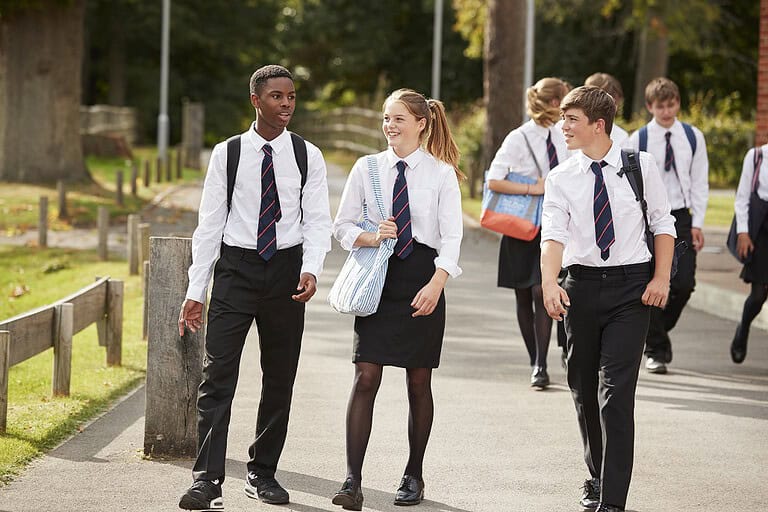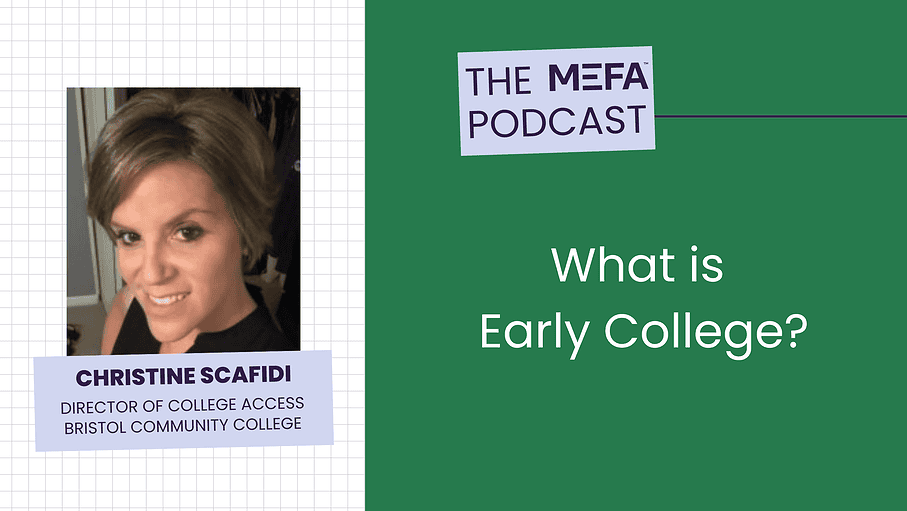Resources Mentioned in this Episode
Christine Scafidi: [00:00:00] That early college is college credits during high school with wraparound services. So we are teaching a student that may not have seen college as an option for themselves. We’re teaching them how to be a college student during high school. So they’re taking a college level course while they’re a high school student.
So they’re double dipping, if you will. They might be taking an English class that will also be their high school graduation equivalent. At the same time as high school and they’re getting what we would consider wraparound services. So they might have embedded tutoring Or they’re getting writing support They’re getting writing support.
They’re getting counseling. They might be learning to do their bachelor They might be getting tutoring around college applications.[00:01:00]
Jonathan Hughes: Hello everyone and welcome to the MEFA Podcast. My name is Jonathan Hughes and you just heard from our guest on the show today Christine Scafidi and is The Director of College Access at Bristol Community College, and she is going to talk to us all today about early college. What is it? How it can help students in high school to take college courses, get that college experience, graduate high school with some college credits, and the consequent initiative to promote access to early college programs in Massachusetts.
So she’s going to talk about all of that stuff and more. I’ll be back with the wrap up, but now let’s go to my conversation about early college and meet our guest on the show.
Christine Scafidi: My name is Christine Scafidi. I am currently the Director of College Access at Bristol Community College, and we have four campuses on the south coast of Massachusetts.
Our flagship is in Fall River, [00:02:00] but we have campuses in New Bedford, Taunton, and Attleboro as well. I’ve been at Bristol now since March. of 2024. And I’m super excited that people think I’m funny, but I say that my dream job is being at a community college because I’ve been a school counselor working in high schools for about 25 years, but between college admission and high school counseling.
And my niche population has always been students going to college. But I’ve always loved the community college setting because I feel like it’s the perfect place for those students that I love working with the most, which is. that don’t really know what they want to do, but also the early college area of working with students now and dual enrollment is introducing college to high school students who are trying to figure out what they want and trying to put them on a path and even as we’ll talk about what early college and dual enrollment are and their differences.
Really introducing it to a population of students that can really utilize it [00:03:00] as a tool and a pathway to, getting rid of debt, and really going into college with a, with an idea of what they want and figuring things out, but not, it’s okay to make mistakes. It’s okay to try things and figure out what you don’t want, but also putting yourself on a pathway where. You’re trying things out with lots of support.
Jonathan Hughes: What is Early College?
Christine Scafidi: It’s really funny. I worked in it for GEAR UP, which was under the Department of Higher Ed umbrella in the Office for Student Financial Assistance, which was in seven communities across Massachusetts, and through that work, I was introduced to early college and, more dual enrollment, which were scholarship type programs or programs where students would be introduced, in those communities were also these early college and dual enrollment programs, and dual enrollment is statewide, and we’ll talk more about the nuances of that in a second, but as I was working in GEAR UP and going across the state in those seven communities.
I was hearing more and more about early [00:04:00] college and I was thinking, what is this early college thing? And I was recognizing that it was parallel adjacent to gear up in that it was underserved students in the state of Massachusetts who were in, our poverty stricken communities.
Our black and brown students are students who are historically marginalized and were not attending college. And Massachusetts has a program with DESE, where the Department of Elementary and Secondary Education has funding available for a high school to partner with an institute, institution of higher education to put together a program specifically designated to serve those students.
And so a school can identify a population, a cohort of students, Who would start taking college level courses during high school. And so those students would be cohorted together to take a number of credits. The hope is 12 credits. The dream is an Associate’s Degree. That’s very high level [00:05:00] performance.
But, the hope was that they would be taking You know, maybe their English credit, maybe a social science credit a math, a history, something like that, but building towards having, 12 college credits by the time they graduated from high school.
Jonathan Hughes: So how do school districts or schools partake in this program? Who gets the ball rolling?
Christine Scafidi: Anyone can get the ball rolling. So say I was a school counselor in a community that had a high population of deaf students. of students that were underrepresented or underserved. I could, go to the principal of the school, the superintendent of the school district.
I could go to a colleague that works in one of the area, the local colleges or universities. I could go to Bridgewater State or Framingham State or Worcester State or a community college and say, I have this population of students that need to be served. Can I partner with you? Can we write the grant for an Arlington College program together?
And the grant is very structured and you have to [00:06:00] fill out the grant specifically to serve. You have to look at your demographics. You have to write a narrative. Just if anyone’s ever written a grant, you know that they’re not easy, right? They put you through the paces, they make you work hard for it because it’s a lot of money.
And so they put you through a part a and you have to make it through part a before you can make it to part B and part B is even harder than part a and you have to really put together a very strong reason for why the state would give you this money to run this program. And once you’re approved and you’re a designated program, then you hit the ball, you hit the ground running with you have funding for resources.
The government the state would then reimburse the college for the college credits that are awarded in the program. And it might fund a I know some school districts have a school counselor that is funded by this money. Some school districts have a coordinator that might work with the college with this money.
There’s a lot of funding. We’re talking in the millions of dollars [00:07:00] that are funded through this program. But it, in Massachusetts, it is a funded program specifically by grants. There’s something very interesting that I just learned. I went to my first National Association of Concurrent Enrollment Programs, and now that’s very interesting.
I’m going to explain that in just a moment. But Massachusetts is one of the few states in the United States that runs this program by grant. In most states in the United States, this is a, they call it either concurrent enrollment, or they call it early college, dual enrollment, concurrent enrollment, are all the same.
Okay. In other places. This is where of course, Massachusetts very special Because we’re our hoity toity Massachusetts educated people, right So in Massachusetts, you have early college, which is a designated grant application and then we have dual enrollment and dual enrollment is the [00:08:00] con that we have a couple of different ways That dual enrollment is done in Massachusetts, but nationally it’s all the same thing So there isn’t another state that does Early college the way we do early college here which is and I’m actually proud of the way Massachusetts does early college because They make sure that the money is designated and determined to go to a mission and our mission is to fix the system So that these students who have been historically marginalized and not included are getting included now.
And we make sure that those communities get the dollars so that these students are on a pathway, be it, they may choose a certificate, they may choose an associate. It doesn’t matter. The bottom line is that they’re getting the programming. Now, we’ll come back to the other definition in just a second, but what makes the early college program so special is that early college is college credits during high school with wraparound [00:09:00] services.
So we are teaching a student that may not have seen college as an option for themselves. We’re teaching them how to be a college student during high school. So they’re taking a college level course while they’re a high school student. So they’re double dipping, if you will. They might be taking an English class that will also be their high school graduation equivalent at the same time as high school.
And they’re getting what we would consider wraparound services. So they might have embedded tutoring. They may have on the, so if you remember taking college classes. Probably two, maybe three days a week. And then on the off days you had other classes. So in high school with their schedule where they would typically meet every day on those off days, they’re getting tutoring or they’re getting writing support, they’re getting counseling.
They might be learning to do their FAFSA. They might be getting tutoring around college applications. They’re getting a lot of other wraparound support and things that they might not have gotten if they were not enrolled. [00:10:00] in a cohort of early college students. So there’s a lot more that’s going into the program than them just taking a college class.
Jonathan Hughes: Now, you mentioned a cohort of students that may be eligible for early college. And I know this decision to participate in early college comes at the school level, but within the school then, are certain students identified, or is the entire population available to do early college? How does it work from there?
Christine Scafidi: For example, and I’ll just, so we have Durfee, we have New Bedford High School at Bristol. Bristol and those populations, they pick cohorts, their cohorts are representative of their entire student population but we do look at the early college programming does need to meet the criteria of the demographics for the program.
So they’ve written the designation, they’ve written the grant based on meeting the needs of this program. a particular population of students. The school counselors typically [00:11:00] work the principals, the teachers might recommend students to, they might want to opt in to an early college program.
Just like there are some students that might leave an early college program. It depends on what the recommendations are for the program. So typically they’re identified and they’re, you might decide in middle school that you want to do early college. These are the programs that we’re talking with students.
This is one of the many reasons that the my cap was developed as well because we were seeing in middle school and I was part of the conversations and helping develop the my cap over the last several years too, was this was one of the reasons that my cap was developed because we were seeing that students were having to face in middle school, coming eighth grade, what they wanted to do.
And so we had students that were choosing career technical high schools or they were choosing You know, do we want to go to high school for a vocational program? Do I want to go to high school and do early college? How do they were all these opportunities and trying to figure out what they wanted to do, but they weren’t getting [00:12:00] any type of advising in middle school to help them make that decision.
And then you get two years into high school and you think, Oh, I wish I had gone to school for carpentry and now it’s too late. You’re already a sophomore in high school and you’ve missed your opportunity for admission to that school. And now there’s wait lists right at the vocational schools.
So sometimes students were getting too far into their high school career and they were missing opportunities for other programming that would have had to start. You would have had to make that decision in eighth grade. So by having the, my cap, my career and academic plan, which was in middle school, students are doing more of those. career and vocational conversations sooner than later, which is really helping them think about what they’re talented at thinking about, Job shadowing opportunities and career conversations doing print career interest inventories in middle school Whereas when I was first starting I was a school counselor years ago.
We weren’t doing career interest inventories until 10th grade Which seems crazy to me now [00:13:00] because when we think about high school students, we always thought oh You don’t figure out what you want to do or what you want to major in Until your sophomore year of college. And when I think about that now, it makes me cringe because I think, sophomore year of college. Oh my god. You’re about to graduate at that point, you should know what you want to do by then, but it’s everything is being dialed back so early now, but we really do want students to have a plan. Or have some sense of, Some knowing of what they want to do during high school because really that pursuit of College or it could be a career program. It could be a certificate program And so this early college conversation also, we received so much debt
Jonathan Hughes: Yeah, I want to ask about cost a little bit too, because my understanding, I’ve spoken to students who have done dual enrollment programs and they’ve been too young essentially to file a FAFSA, right? And so that means that they had to actually pay for those. Programs. Is that the same with early college or [00:14:00] so early college?
Christine Scafidi: So early college programs are free to all students who participate in those programs. And early college doesn’t impact, once they graduate from high school, they can file a FAFSA and they are, they can file a FAFSA as a senior and then they would have free community college or depending on their circumstances and their FAFSA, they can have a free state university or UMass.
Depending on what their FAFSA and their aid package is. But then also there, there is opportunities for some free dual enrollment programming as well. And so we can switch gears to talk about dual enrollment. Commonwealth dual enrollment program offers every student in Massachusetts has the opportunity to take one free dual enrollment course.
So in that, commonwealth dual enrollment program has been around since, oh my gosh, the early 2000s where the state has basically said, let us let you try college during high school. I, and don’t, I love the opportunity for students to take college level work in high school and I almost prefer [00:15:00] the students were doing them instead of APs because I think APs are so stressful the way they’re, the way that the content is shared and the summer work But I like the And I love the added, the chest puffing up of a student taking a college level course during high school.
I love what that does for their confidence. But a Commonwealth dual enrollment program, any student can take a course. And as I said earlier, they have to take a placement. They have to meet those minimum requirements. But it is possible that students meet those requirements. And the first one is free. And they can register for that through most colleges, like mine, have a college access office.
And they would just register for the course. They would get a signature from their school counselor, and there’s a parent form. And they would just register for the course, and it would process through financial aid, and they would get, the state would get billed for that course, and they would get it for free.
Anything after that would be reduced, can still come through at a reduced cost. Or they would pay for them if they chose to take more after that, but the first one would be free. There [00:16:00] are some other opportunities for free courses. It depends on the high school. Something that a lot of schools don’t know about is High schools, if they want it, say not every school can qualify for an early college program.
But a high school could reach out to me that might not be an early college district Could reach out to me and say hey I’d love to offer My high school an English 101 class I’d love for them to be able to double dip their senior year and have English 101 as their English credit Take it as their high school credit and a college level credit and have the opportunity to try an English class at the college level.
And we happen to have an English teacher at our high school who has their 18 credits in their English content area that could get designated as an adjunct faculty member at Bristol. This is what we would call concurrent enrollment.
Jonathan Hughes: Okay.
Christine Scafidi: We could designate their English teacher as a Bristol faculty member, adjunct faculty. They could teach the English class at their high school as concurrent [00:17:00] enrollment. And they could buy the class from us. And they could teach the class at their high school. And so the school could fund it and buy it. The students would get it for free. A class of, say, 22 students could get English 101 at their high school.
Jonathan Hughes: So this is my question of if students always physically attended the colleges. So not necessarily.
Christine Scafidi: No. And that’s just one example. There could be online classes. They could do online asynchronous. We have online synchronous. There are hybrid courses. So anything in the course catalog could be a dual enrollment course.
So there’s a lot of opportunities for students to dip their toe in the pool during high school and trying these classes as well as over the summer.
Jonathan Hughes: So let me ask you this then. I’m imagining a student listening to this and saying that they want to do this. What should they do then? Is this sort of, does this rest, I guess this goes back to my first question, but, is the student [00:18:00] independent of what?
The school, their high school does, whether or not they have applied to be part of this program, that they’ve got that grant application or not. Do they have an opportunity to do this?
Christine Scafidi: Any student in high school can take A dual enrollment class. Any student. So if they wanted to do this, first of all, if they have any questions, they can reach out to me and I can help them find out who their local college or university is that they’d like to take a class.
It doesn’t have to be a state institution. It does need to be a state institution if they want to take advantage of the Commonwealth Dual Enrollment Program. So it would have to be a state school to get the one free class.
Jonathan Hughes: Okay.
Christine Scafidi: If they lived say in Newton and they wanted to try a class at LaSalle college or LaSalle university, they could take a dual enrollment class at LaSalle university.
They’d have to contact them and register for the class. But if they wanted it to be the one free, they’d have to go through a state university here in Massachusetts to get the one free class. But I would be happy to talk with them. [00:19:00] They need to get their school counselors permission. They have to get.
They’re a parental signature, but there’s an application on our website. You just fill that out and they apply through Our office, and then an advisor will get in touch with them, talk them through the the advising process of why they picked that class, what they’re thinking about, and making sure that they picked the right time and the right location, the right style and modality of class that worked best for their learning style.
We’ll go through all of that with them, and then get them signed up for the class.
Jonathan Hughes: Now going back to the early college with the wraparound services, which is I think the first thing that we were discussing Do you have a sense of how many?
Christine Scafidi: Schools are set up in that program as of now There are 55 programs set up in Massachusetts And I do know that they’re in the middle of the designation process right now. And I believe something like 40 something new grants were submitted, but that [00:20:00] doesn’t mean that all of them, last year, I don’t know how many were submitted. Only three were accepted last year. So when we submitted to Bristol submitted to last year and only one was accepted. And when it wasn’t accepted last year, we resubmitted this year.
So we’re waiting to find out this year if we’re going to make it through part a. To find out if we’ll get submitted. So our hope is that right now we have, of our four campuses, we have three, we were accepted Taunton, our early college program in Taunton High School was accepted last year. And we’d like to have an early college program running, in all of our communities where we have campuses.
So we’re hoping that Attleboro will get accepted this year. So we’re working on that one now, but we’ll keep trying until we get it. But it doesn’t mean, so you have a lot of, it’s a lot of steps and you want to make sure that everything makes sense for the students. And that all the pieces are lining up and all the, all the puzzle pieces are lining up so that the student’s best interest is served and that the community, everyone’s working together and that everything, lines up the [00:21:00] way it’s supposed to so that all the needs are being met.
It’s a lot of logistics, but when it works, it’s amazing, the student success. And I’ve been in all of the schools that we run our programs in, and it’s really something special to watch.
Jonathan Hughes: I wanted to ask you about that. Do you work with early college students in your capacity at Bristol?
Christine Scafidi: I have been really lucky. We also have another program that I haven’t mentioned at all, which is really cool. We have Argosy Collegiate Charter School. There are two what they call wall to wall early college programs in Massachusetts. The second one is the New Heights Charter, which is based out of Massasoit Community College.
What a wall to wall is students attend those charter schools, basically committing to four years of early college work. So there are programs with Durfee, New Bedford and Taunton start well, we back up a little bit. Dorothy and New Bedford start their programs in the 11th grade. [00:22:00] And, Taunton just started this year, it’s our newest program, they’re starting in the 9th grade.
And they’re starting with Spanish, and they’re going to roll out a new class each year till all, they have a program that basically encompasses all four years. Wow. But New Bedford and Dorothy are just 11th and 12th grade right now.
Jonathan Hughes: So that means students as young as 9th grade can be taking college level courses?
Christine Scafidi: Exactly. But they’re starting with Spanish, which a student would be taking as a ninth grader anyway, but they’re taking it an introductory level Spanish at the college level, which is great. With a college professor, from from Bristol. And so Argosy, our is our wall to wall.
And basically they’re starting and their students are enrolled grades nine through 12. And so the expectation is that, or the hope is that they’re gonna graduate with a bachelor an associate’s degree. I correct myself with-
Jonathan Hughes: Graduate from high school with an associate’s degree.
Christine Scafidi: Yes.
Jonathan Hughes: Wow. So-
Christine Scafidi: That’s the hope. And so they, they basically enter ninth grade knowing that they’re going to have four [00:23:00] years of college credit. That they’ll be taking the entire time. So every student goes in knowing that they will have four years of college credits. The whole, every class they take will be college level.
Jonathan Hughes: Wow.
Christine Scafidi: And there’s only two of those that exist in Massachusetts. And we have one of them at Bristol. And so they also have space on our campus. They have classrooms and offices on our campus. They come and spend. The first half of their day with us, and then they go back to their campus in Fall River.
Jonathan Hughes: Wow.
Christine Scafidi: We have regular meetings with them to talk about scope and sequence, and what courses they’re taking, how we can serve their students better.
They can use our library. They use our dining room. They use our, they go to the bookstore. They basically are on our campus full time.
Jonathan Hughes: This initiative was begun by the Commonwealth back in, as you say, 2017, I think it was the early college initiative. I wonder if we could finish just by articulating what the scope, what the goal was or is of the program. And then. Now, how are we doing and how, what would we like to see from this program? And is this something that we are seeing?
Christine Scafidi: We’ve been really fortunate [00:24:00] with Governor Haley coming in, we have, the program has remained funded now a couple of years we’ve gotten really great funding.
The goal is for there to be, as of right now, I think almost 8, 000 students enrolled across Massachusetts in those 55 programs, and the goal is to have by 2030. 25, 000 students enrolled. That’s the goal which is a huge goal. But when we think about the trajectory and the correction and the system of the students that we’re serving, right?
We know that in college I was in college admission for a number of years and we knew that there was a cliff, that there was going to be a drop off in in population of this age of student, we knew that there was going to be a spike in our Hispanic student population as well.
So we knew that there was going to be a need for doing something unique and special to increase our numbers of attendance and really correct the system for what was many years of, loss where we had a group of students that were not being served. [00:25:00] And so I really do think that we’re seeing an increase.
We’re seeing success, we’re seeing students coming back saying, wow, this mattered. This really helped me And and I have been able to get into the schools to get back to your earlier point I have been able to see these students. I have been sitting in classes in New Bedford all semester it’s been really something to see their success I sat with a student and her mom and advised her on some colleges that she was looking at And it really was it really is special.
They’re very bright kids. They’re really excited You they like, they really do feel special. They really do feel like this was special for them. They really are excited about it. And so it’s really been it’s been awesome. And I think that, we’re doing something that it’s hard to believe, as I was saying earlier, snooty Massachusetts, but we’re behind.
We’re really behind. Other states have been doing this for a lot longer than us. We, Connecticut already has 17, 000 students doing that.
And they’ve been doing it. Other states like Texas and Colorado and Florida, even [00:26:00] Oregon, are doing this better than we are. We have a lot of catching up to do in this area which makes me sad, but at the same time I, like I said earlier, I am really proud of how Massachusetts has really made this a mission, more than just, giving it out to everyone.
I do like that DESE has made this a priority to serve a population of students, and it really is a mission, it’s a movement, and I’m really proud of that, and I’m committed to keeping the work of really building these students toolboxes to make them stronger students. I really do love that, and I think that our faculty are coming to understand and appreciate early college more now that they understand it better.
I think that’s a big part of it as well. I think that we all got thrust into it and I think now that we’re learning more about it and understanding it, I think we all have a greater appreciation for it as well, which is really nice because I think the students are just really excited to be given the opportunity now that it’s free.
Now the community college and even because the state has put so much money into financial aid.
Jonathan Hughes: Yeah.
Christine Scafidi: That, that education is becoming so [00:27:00] much more affordable for students. And that fear of, I can’t go to college because it’s too expensive. I think we’re taking that away as a variable. I think that’s really changing the landscape for students and they’re seeing possibilities in ways that they didn’t see them before.
And I think that’s just really huge.
Jonathan Hughes: I agree. And I love conversations like this because it makes you feel really hopeful about the future of education in Massachusetts. So thank you for Is there anything else you’d like to say before we go?
Christine Scafidi: No, I just want to thank you for the opportunity to share, the news about what Early College and Dual Enrollment are. And I hope that people will reach out if they have any questions. And I, I’d be happy to share names and connections and contact people that I know in the field. And help happily, get people connected with their right contacts so that they can move forward and take advantage of these opportunities.
Jonathan Hughes: How can they contact you?
Christine Scafidi: My email address is [email protected].
Jonathan Hughes: Well, I appreciate that very much. And again, I [00:28:00] appreciate you coming on the show. And I, again, I really do mean it. I think we have a lot of really exciting things happening at the state level in Massachusetts, and this is one of them.
Christine Scafidi: So thank you so much. Yeah. Thanks for having me. It’s been great.
Jonathan Hughes: All right, folks. That about wraps it up for our first show of 2025. I want to thank Christine Scafidi for. Sharing her time and her expertise with us today and folks if you liked what you heard and you want to know more from us about planning, saving, and paying for college and career readiness as well as reaching financial goals, then you can follow the show and you can do that wherever you find your podcasts and please remember to rate and review the show.
It helps us keep doing what we’re doing and getting the show out in front of folks. just like yourselves. So I would like to thank [00:29:00] our producer Shaun Connolly. I’d like to thank AJ Yee, Lisa Rooney, Lauren Danz and Meredith Clement for their assistance in getting the show posted. Happy 2025 everybody. Once again, my name is Jonathan Hughes and this has been the MEFA Podcast.
Thanks.









